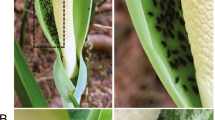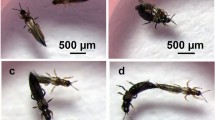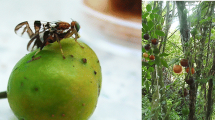The thrips taxon, Frankliniella schultzei Trybom, could possibly comprise a complex of unrecognised cryptic species. We therefore made a range of reproductive behavioral observations on F. schultzei individuals from different host-associated populations to investigate their species status. We first described the mating behavior of F. schultzei taken from flowers of a primary host species, Malvaviscus arboreus. The pattern of male-female interaction was complex and protracted, with several behavioral steps being performed. These steps were similar for all mating pairs. Most females responded to male presence before physical contact, suggesting that male pheromones may be involved. We then compared mating behaviors, brood sizes and sex ratios of F. schultzei pairs derived from different host plant species. All pairs in crosses regardless of their original host plant species produced female offspring, indicating successful mating. Frequencies of behaviors were similar for all pairs. Only those crosses involving F. schultzei individuals from Erythrina crista-galli flowers differed from the general pattern in pre-copulation and copulation times. The females from E. crista-galli also produced significantly fewer offspring than females from other crosses. Finally we used traps baited with males from two populations, but set among flowers of one host plant species, to test for differential attraction of females. We found no evidence that the different host-associated populations investigated differ from one another functionally in their sex pheromone system. However, these results do not yet discount the possibility of cryptic species within the taxon F. schultzei. Populations of F. schultzei on many other host species need to be investigated from this perspective.

Similar content being viewed by others
REFERENCES
Abeeluck, D., and Walter, G. H. (1997). Mating behaviour of an undescribed species of Coccophagus near C. gurneyi (Hymenoptera: Aphelinidae). J. Hymenop. Res. 6: 92–98.
Amin, P. W., Reddy, D. V. R., and Ghanekar, A. M. (1981). Transmission of tomato spotted wilt virus, the causal agent of Bud Necrosis of peanut, by Scirtothrips dorsalis and Frankliniella schultzei. Plant Dis. 65: 663–665.
Bedford, H. W. (1921). The Cotton Thrips (Heliothrips indicus, Bagnall) in the Sudan: With a Description of its History and Habits in the Gezira (Blue Nile Province), and Measures for its Control, Entomological Section Bulletin No. 18, Sudan Government.
Claridge, M. F., Den Hollander, J., and Morgan, J. C. (1985). The status of weed-associated populations of the brown planthopper, Nilaparvata lugens (Stål) --- host race or biological species. Zool. J. Linn. Soc. 84: 77–90.
Claridge, M. F., Den Hollander, J., and Morgan, J. C. (1988). Variation in hostplant relations and courtship signals of weed-associated populations of the brown planthopper, Nilaparvata lugens (Stål) from Australia and Asia: A test of the recognition concept. Biol. J. Linn. Soc. 35: 79–93.
Conover, W. J. (1980). Practical Nonparametric Statistics, John Wiley and Sons, New York.
Coutts, B. A., and Jones, R. A. C. (2005). Suppressing spread of tomato spotted wilt virus by drenching infected source or healthy recipient plants with neonicotinoid insecticides to control thrips vectors. Ann. Appl. Biol. 146: 95–103.
Coutts, B. A., Thomas-Carroll, M. L., and Jones, R. A. C. (2004). Patterns of spread of tomato spotted wilt virus in field crops of lettuce and pepper: spatial dynamics and validation of control measures. Ann. Appl. Biol. 145: 231–245.
de Kogel, W. J., and van Deventer P. (2003). Intraspecific attraction in the western flower thrips, Frankliniella occidentalis; indication for a male sex pheromone. Entomol. Exp. Appl. 107: 87–89.
Fernando, L. C. P., and Walter, G. H. (1997). Species status of two host-associated populations of Aphytis lingnanensis (Hymenoptera: Aphelinidae) in citrus. Bull. Entomol. Res. 87: 137–144.
Franssen, C. J. H., and Mantel, W. P. (1964). Notes on copulation of thrips. Tijdschrift Entomol. 107: 341–344.
Goyer, R., Paine, T., Pashley, D., Lenhard, G., Meeker, J., and Hanlon, C. (1995). Geographic and host-associated differentiation in the fruittree leafroller (Lepidoptera: Tortricidae). Ann. Entomol. Soc. Am. 88: 391–396.
Hamilton, J. G. C., Hall, D. R., and Kirk, W. D. J. (2005). Identification of a male-produced aggregation pheromone in the western flower thrips Frankliniella occidentalis. J. Chem. Ecol. 31: 1369–1379.
Kirk, W. D. J. (1984). Ecological studies on Thrips imaginis Bagnall (Thysanoptera) in flowers of Echium plantagineum L. in Australia. Aust. J. Ecol. 9: 9–18.
Kirk, W. D. J. (1985). Aggregation and mating of thrips in flowers of Calystegia sepium. Ecol. Entomol. 10: 433–440.
Kirk, W. D. J. (1987). A key to the larvae of some common Australian flower thrips (Insecta: Thysanoptera) with a host-plant survey. Aust. J. Zool. 35: 173–185.
Kirk, W. D. J., and J. G. C. Hamilton (2004). Evidence for a male-produced sex pheromone in the western flower thrips Frankliniella occidentalis. J. Chem. Ecol. 30: 167–174.
Leniaud, L., Audiot, P., Bourguet, D., Frérot, B., Genestier, G., Lee, S. F., Malausa, T., Pallec, A.-H. L., Souqual, M.-C., and Ponsard, S. (2006). Genetic structure of European and Mediterranean maize borer populations on several wild and cultivated host plants. Entomol. Exp. Appl. 120: 51–62.
Milne, J. R., Khumlekhasing, M., and Walter, G. H. (1996a). Understanding host plant relationships of polyphagous flower thrips, a case study of Frankliniella schultzei (Trybom). In Goodwin, S., and Gillespie, P. (eds), Proceedings of the 1995 Australia and New Zealand Thrips Workshop: Methods, Biology, Ecology and Management, NSW Agriculture, Gosford, pp. 8–14.
Milne, J. R., Walter, G. H., Kaonga, D., and Sabio, G. C. (1996b). The importance of non-pollen plant parts as food sources for the common blossom thrips, Frankliniella schultzei. Entomol. Exp. Appl. 78: 271–281.
Milne, M., and Walter, G. H. (1997). The significance of prey in the diet of phytophagous thrips, Frankliniella schultzei. Ecol. Entomol. 22: 74–81.
Milne, M., and Walter, G. H. (2000). Feeding and breeding across host plants within a locality by the widespread thrips Frankliniella schultzei, and the invasive potential of polyphagous herbivores. Div. Dist. 6: 243–257.
Milne, M., Walter, G. H., and Milne, J. R. (2002). Mating aggregations and mating success in the flower thrips, Frankliniella schultzei (Thysanoptera: Thripidae), and a possible role for pheromones. J. Insect Beh. 15: 351–368.
MINITAB (1989). Data Analysis Software. Release 7.2, State College, PA.
Moritz, G. (1997). Structure, growth and development. In Lewis, T. (ed.), Thrips as Crop Pests, CAB International, Oxon, UK, pp. 15–63.
Mound, L. A. (1968). A review of R. S. Bagnall's Thysanoptera collections. Bull. Br. Mus. (Nat. Hist.) 11: 1–81.
Mound, L. A., and Marullo, R. (1996). The thrips of Central and South America: An introduction. Memoirs Entomol., Int., 6: 1–448.
Palmer, J. M. (1990). Identification of the common thrips of tropical Africa (Thysanoptera: Insecta). Trop. Pest Manage. 36: 27–49.
Paterson, H. (1985). The recognition concept of species. In Vrba, E. (ed.), Species and Speciation, Transvaal Museum, Pretoria, pp. 21–29.
Paterson, H. E. H. (1991). The recognition of cryptic species among economically important insects. In Zalucki, M. P. (ed.), Heliothis: Research Methods and Prospects, Springer, New York, pp. 1–10.
Pelikan, J. (1952). On carnation thrips Taeniothrips dianthi Pr. Entomol. Listy 14: 5–38.
Sakimura, K. (1969). A comment on the color forms of Frankliniella schultzei (Thysanoptera: Thripidae) in relation to transmission of the tomato-spotted wilt virus. Pac. Insects 11: 761–762.
SAS (1988). SAS, Version 6.03, SAS Institute Inc., NC.
Terry, L. I. (1997). Host selection, communication and reproductive behaviour. In Lewis, T.. (ed.), Thrips as Crop Pests, CAB International, Oxon, UK, pp. 65–118.
Terry, L. I., and Gardner, D. (1990). Male mating swarms in Frankliniella occidentalis (Pergande) (Thysanoptera: Thripidae). J. Insect Behav. 3: 133–141.
Terry, I., and Schneider, M. (1993). Copulatory behaviour and mating frequency of the western flower thrips, Frankliniella occidentalis (Insecta: Thysanoptera). J. Pure Appl. Zool. 4: 339–354.
Ullman, D. E., Sherwood, J. L., and German, T. L. (1997). Thrips as vectors of plant pathogens. In Lewis, T.. (ed.), Thrips as Crop Pests, CAB International, Oxon, UK, pp. 539–565.
Vanlerberghe-Masutti, F., and Chavigny, P. (1998). Host-based genetic differentiation in the aphid Aphis gossypii Glover, evidenced from RAPD fingerprints. Mol. Ecol. 7: 905–914.
Vierbergen, G., and Mantel, W. P. (1991). Contribution to the knowledge of Frankliniella schultzei (Thysanoptera: Thripidae). Entomologische Ber. (Amsterdam) 51: 7–12.
Walter, G. H. (1993). Mating behaviour of two closely related Ochraceus-group Coccophagus species (Hymenoptera: Aphelinidae). Afr. Entomol. 1: 15–24.
Walter, G. H. (2003). Insect Pest Management and Ecological Research, Cambridge University Press, Cambridge.
Wilson, L. J., and Bauer, L. R. (1993). Species composition and seasonal abundance of thrips (Thysanoptera) on cotton in the Namoi Valley. J. Aust. Entomol. Soc. 32: 187–192.
Wilson, L. J., Bauer, L. R., Sadras, V. O., and Walter, G. H. (1996a). Phytophagous thrips as predators of spider mites and as pests on cotton. In Goodwin, S., and Gillespie, P. (eds), Proceedings of the 1995 Australia and New Zealand Thrips Workshop: Methods, Biology, Ecology and Management, NSW Agriculture, Gosford, pp. 93–96.
Wilson, L. J., Bauer, L. R., and Walter, G. H. (1996b). ‘Phytophagous’ thrips are facultative predators of twospotted spider mites (Acari: Tetranychidae) on cotton in Australia. Bull. Entomol. Res. 86: 297–305.
ACKNOWLEDGEMENTS
We thank Michael Ryan for comments on earlier drafts. Financial support from the Australian Agency for International Development is thankfully acknowledged.
Author information
Authors and Affiliations
Corresponding author
Rights and permissions
About this article
Cite this article
Milne, M., Walter, G.H. & Milne, J.R. Mating Behavior and Species Status of Host-Associated Populations of the Polyphagous Thrips, Frankliniella schultzei . J Insect Behav 20, 331–346 (2007). https://doi.org/10.1007/s10905-007-9081-4
Revised:
Accepted:
Published:
Issue Date:
DOI: https://doi.org/10.1007/s10905-007-9081-4




